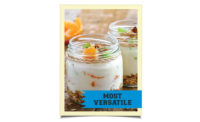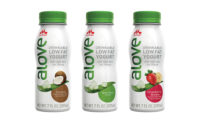We dusted off the jukebox to play the songs that best represent dairy foods and beverages. Our annual State of the Dairy Industry report examines the prospects for all dairy categories. For the cultured dairy category, we selected Springsteen’s “Glory Days.” It’s no surprise that cultured dairy products (especially Greek yogurt) is at the top of the charts.
Yogurt still has the attention of consumers. It’s everywhere and it seems to be in everything. But, the consensus among many processors is clear — the novelty with Greek yogurt has worn off. Though it’s still popular, the shelf space is getting crowded and other styles of yogurt (like dessert-style, full-fat, Aussie and European) and other cultured product innovations are gaining interest and pulling once-loyal Greek yogurt consumers to a new side.
Yogurt is a food with many day-parts. It is eaten for breakfast and lunch and consumed as a snack in the morning or afternoon, and interest beyond these occasions is building. Recently, yogurt makers are trying to expand into the evening with sweeter yogurts marketed as desserts.
Yogurt consumption has gone up by 129.2% since heading into the new millennium, according to the U.S. Department of Agriculture’s National Agricultural Statistics Service, going from 6.5 pounds per capita in 2000 to 14.9 pounds in 2013. A different measurement shows the same result. Yogurt sales increased from 1.8 billion pounds in 2000 to 4.7 billion pounds in 2013, according to the USDA.
In the 52 weeks ended Aug. 10, 2014, the yogurt category’s dollar sales went up 4.3% to $7.2 billion and unit sales increased slightly by 1.8% to 5.1 billion, according to data from Chicago-based IRI.
“Greek yogurt is still a leading trend spreading out from the United States through the United Kingdom and into other parts of Europe. The U.S. Greek yogurt sector has not only continued to grow, now accounting for about 40% of the U.S. $7-billion-plus market, but also seems to have boosted interest in yogurt consumption in general,” said Lu Ann Williams, director of innovation, Innova Market Insights.
Though much credit can be given to Greek yogurt for shining a light on the yogurt industry, the interest in international-style yogurts continues to build as new products pop up on the market, like Tarté Asian yogurt produced by Tarte Foods LLC, Santa Monica, Calif. This Vietnamese-style yogurt has a lighter texture and less-sweet taste, yet it still has a high-protein content, approximately 13 to 14 grams of protein per 6-ounce serving.
As Pete Kondrup, general manager, Westby Cooperative Creamery, Westby, Wis., said, “It seems like we may soon have a yogurt ‘style’ for every country and nationality in the world; which is great for our dairy industry.”
Interest in European-style yogurts is being driven by the PepsiCo-Müller yogurt joint venture (Müller Quaker Dairy) formed in 2011, initially using imported products, but now producing yogurt at a new plant in upstate New York that opened in 2013 (see the June 2014 Dairy Foods). Müller Quaker Dairy, Chicago, expanded its Müller Corner line earlier this year with the launch of dark chocolate with cherry, raspberry and pecan granola. Each variety blends dark chocolate shavings into low-fat yogurt and pairs it with combinations of fruit or crunchy clusters.
Bellvue, Colo.-based Noosa Yoghurt, added two tropical flavors (coconut and pineapple) and a plain flavor to its line of Aussie-style yogurts. Wallaby Organic, American Canyon, Calif., produces an organic Australian-style blended yogurt that has over 20 varieties and flavors. The line includes flavors like Key lime, lemon, maple and orange passion fruit in the low-fat variety; and Bartlett pear, blackberry and mango lime as some of the options in the nonfat.
Read more about how international-style yogurts are shaking up the yogurt market on dairyfoods.com. See the article: “Yogurt wars: Can anything compete with Greek?”
All about dessert
Exotic and unique flavor combinations and dessert-inspired flavors are showing up across the yogurt aisle. The push to see yogurt beyond breakfast and snacking occasions has processors getting innovative with dessert options.
“The Greek trend is starting to slow down as it becomes more of a new normal. Currently, we are seeing a trend toward dessert flavors,” said Pamela Zager, marketing director for Alpina Foods, Batavia, N.Y. “According to Chicago-based Mintel, more than a quarter of category participants eat yogurt as a dessert. Consumers are looking for flavors that they can indulge in, without all of the calories associated with a dessert.”
Alpina Foods added a new sweet variety — mini chocolate gems — to its Bon Yurt line, which features low-fat vanilla yogurt with mix-ins on top. The line also has a cookies-and-cream flavor mix-in.
Tapping directly into dessert occasions is The Dannon Co., White Plains, N.Y., with its introduction of Dannon Creamery, a new brand of pudding- and cheesecake flavor-inspired dairy desserts sold in 5.3-ounce cups. The new line includes five cheesecake flavors which are made with Greek yogurt and have a consistency similar to cheesecake. Flavors include strawberry, lemon and caramel. Its pudding, made with Grade A milk, comes in dark chocolate, milk chocolate and vanilla.
Tillamook County Creamery, Tillamook, Ore., launched a dessert yogurt line last year with flavors like Honey Cinnamon Crème Brûlée and Marionberry Cobbler. Low-fat lemon cream pie, fat-free lemon chiffon and Key lime pie are some of the new dessert-inspired flavors added to Carlinville, Ill.-based Prairie Farms Dairy’s line of 6-ounce yogurts.
Londonberry, N.H.-based Stonyfield introduced an entirely different concept to its line this year, a spoonable fresh sweet cheese called Petite Crème that’s modeled on fromage blanc, a silky-sweet fresh cheese popular in France but eaten just like yogurt. It can be found in the yogurt aisle at U.S. grocers and is high in protein (10 to 12 grams per serving) like Greek yogurt with a mild, creamy taste and texture.
Some of the “cutting edge trends” Stonyfield has been seeing are “really elevated flavors and flavor combinations that include ingredients like blood orange, passion fruit, coconut and even veggies such as tomato and carrot,” said Amy Elkes, senior marketing and insights manager.
As part of its big product launch this year, Greek yogurt giant Chobani, Berlin, N.Y., created the brand’s first dessert product — Chobani Indulgent. It’s made with full-fat Greek yogurt and comes in eye-catching clear packaging. The flavors include raspberry dark chocolate chunk and mint dark chocolate chunk.
Yogurt for dessert is showing up beyond the grocery store as well. According to Chicago-based Technomic’s MenuMonitor report, yogurt incidence on menus is down overall by 3%, but it’s up in desserts, with 8% more desserts featuring yogurt. Dannon, among others, has responded with a foodservice line.
Is full-fat yogurt the next big thing?
Dairy Foods’ columnist Phillip Tong posed this question about higher milk fat as the possible next big thing in the September 2014 issue. As he wrote in his article, health professionals have been trying to convince us that fat was bad since the 1980s. But that notion is now being challenged. Tong said, “As more scientific studies supporting the benefits of milk fat in the diet get translated to consumer news media, consumer behavior will likely change and drive the food industry to respond.”
And they are responding. Another trend that’s showing up alongside the yogurt-as-dessert concept is an increased demand for full-fat products (also in combination with grass-fed products). According to processors we’ve spoken with, this interest goes beyond just a desire for creamier yogurt — it’s about health and getting back to the root of how yogurt was originally made.
Maple Hill Creamery, Stuyvesant, N.Y., has been producing organic, grass-fed, full-fat yogurt since 2009. Maple Hill created its line with the desire to “stay true to the origins of yogurt, which traditionally had been made with whole milk until very recently,” according to Sara Talcott, director of marketing and communications.
She pointed out that whole-milk yogurts have actually been in demand and popular for a while among a specific health-focused crowd, but it’s definitely making its way into the mainstream. The same goes for grass-fed yogurts (milk from exclusively grass-fed cows), which is also gaining in popularity as consumers are becoming more mindful about the origins of their food, said Talcott.
Maple Hill produces a creamline (or cream-top)-style of yogurt in 6- and 32-ounce sizes in a variety of flavors and 12-ounce drinkable yogurts. Cream rises to the top in the culturing process because the milk is not homogenized. Cream-top yogurts aren’t new, but consumers are taking more notice of them as the conversation turns to whole-milk yogurt. Maple Hill has seen significant growth in the last year and a half, with its products going from having a presence in 600 stores to about 5,000.
Capitalizing on this interest and the still popular Greek yogurt, Maple Hill also introduced a whole-milk Greek yogurt this fall, one that is “less sweet” than other Greek yogurts. Talcott described it as thicker than its creamline-style.
“We tend to see two different groups of people when it comes to interest in fat. The first group is driven by the health benefits associated with full-fat dairy, and specifically full-fat organic dairy, as recent research has shown high concentrations of healthy omega-3 fatty acids in the fat of organic milk. The second group is motivated by taste,” said Stonyfield’s Elkes.
Brown Cow, a brand of Stonyfield, has been making cream-top yogurts for years. And now Stonyfield is launching another line of whole milk cream-top yogurts under the new Oh My Yog line this January. The yogurts will come in six flavors, including strawberry, gingered pear, apple cinnamon and orange cranberry.
Even Chobani got into the full-fat game with Chobani Kitchen, a 4% whole-milk plain option intended to be used as an ingredient or as a topping for other foods like a baked potato, chili and fajitas. Its new Indulgent line is also made with 4% full-fat Greek yogurt.
Atanas Valev, the owner and creator of Trimona Bulgarian yogurt, Port Jefferson, N.Y., believes whole milk from specifically 100% grass-fed cows is the way to go, and that the market will probably see makers of Greek yogurt switching to the full-fat milk source in the next three to four years, based on new publicity that proves its benefits. Trimona is an organic yogurt that’s made with milk from grass-fed cows. It’s currently available in a plain variety.
Dreaming Cow, Pavo, Ga., which also produces a grass-fed, full-fat cream-top yogurt has seen exceptional growth recently. The company finished a major plant expansion in late 2013 and is now in the process of adding additional capacity to keep up with the demand.
New equipment has allowed Dreaming Cow to be more efficient “We will be able to pack out an additional 12,000 cups an hour, and this along with several major end-of-line automation improvements will increase our efficiency several times over,” said CEO Kyle Wehner.
Wehner attributes the company’s growth to an increased demand for grass-fed products, and added, “grass-fed is getting huge…we are seeing all the major retailers bring on grass-fed brands.”
Getting innovative
Attempting to pull attention back in their direction, processors of Greek yogurt are focusing on seasonal flavors, mix-ins and functional formulas by adding grains — like oats. Just take a look at what Chobani is doing to keep the conversation on Greek. This year the company launched a series of products that emphasized its multiple occasion use (like with its Kitchen and Indulgent line) along with new seasonal and functional offerings. Taking a page from Starbucks’ playbook, its new limited-batch products offer seasonal options throughout the year. Last summer it released watermelon and pink grapefruit flavors, and its newest options this fall were pumpkin spice and apple cinnamon. On the functional end, the company introduced Greek yogurt mixed with fruit and whole grain steel-cut oats, in flavors like banana maple and apple cinnamon.
“The Greek phenomenon also triggered a rise in interest in protein content, men’s yogurts and in the launch of Greek-style variants in a whole range of other dairy products, including drinkable fermented products, frozen yogurts and dips,” said Williams from Innova Market Insights.
Miami Beach, Fla.-based Powerful Yogurt created its new PLUS+ products made with its high-protein Greek yogurt and additional whole grains and seeds. The initial flavors are coconut and quinoa, tropical fruit and oats, and lemon and chia.
This fall, Stonyfield also answered the call with its Greek yogurt with fruit and chia seeds at the bottom, available in three flavors: blueberry, strawberry/cranberry and blood orange.
Dannon added seasonal options in its Oikos Greek yogurt line with a pumpkin pie flavor on shelves until December, followed by a gingerbread flavor for the holidays, beginning in December into early January. In its Light & Fit Greek line it added a caramel apple pie flavor, available until December.
Bold dairy dips and cottage cheeses
While the yogurt category can’t seem to go wrong, the story isn’t the same in other cultured categories. Processors of cottage cheese, cream cheese and sour cream are scrambling to catch up by focusing on bold flavors.
Among the other cultured categories in IRI’s database, sour cream and cream cheese saw the best numbers. In the 52 weeks ended Aug. 10, 2014, sour cream’s dollar sales were up 1.5% to $1.1 billion, units were up 0.4%, while cream cheese dollar sales were up 3.5% to $1.5 billion, though units fell 1.4%, according to IRI. The cottage cheese category struggled; dollar sales were down 0.3% to $1 billion and units dropped 2.6%.
Philadelphia Cream Cheese, a brand of Kraft Foods, Northfield, Ill., dominated the brick and the soft cream-cheese segments with sales of $434.9 million and $413.2 million, respectively. (See table on page 58.) Last spring Philadelphia reformulated its cream cheeses with added fruits and vegetables, and redesigned its packaging with a new look and stackable shape. This fall, the company launched a bold new savory flavor — bacon — teaming up with Oscar Mayer (another Kraft brand) to include real bacon pieces in its cream cheese spread.
On the dairy dip side, Kraft launched new Taco Bell sour cream dips in three varieties: creamy jalapeno, spicy habanero and chipotle. The dips contain 60 calories per 2-tablespoon serving.
HP Hood, Lynnfield, Mass., also focused on bold flavors this year. The company added two new savory flavors of cottage cheese — garden vegetables and cucumber with dill — joining its existing chive and chive & toasted onion flavors. In the cottage cheese segment, Hood’s numbers were significantly up. Dollar sales rose 7.6% to $30.5 million, while units were up 10.8%, according to IRI.
In its Heluva Good! brand, Hood released the limited-edition roasted garlic and caramelized onion sour cream dip. Hood’s sour cream numbers were also up, dollar sales by 5.8% and units by 6.4%.
Though Westby didn’t release anything new this year, Kondrup said he expected “a lot of future flavor explorations, especially on savory flavors for dips. Everyone in the industry knows that dairy products are an excellent carrier of flavor, especially dairy dips with a sour cream base. It’s that rich and creamy real sour cream taste that is the foundation for any added flavor.”
Now if more cultured processors can just get on board with new innovations and flavors in things like cottage cheese and dairy dips, they just might be able to improve sales.
And while these are truly the “Glory Days” for the yogurt industry, as Bruce Springsteen sings in his 1985 classic, if processors don’t continue to build on these new trends, these “Glory Days, well they’ll pass you by.”


















